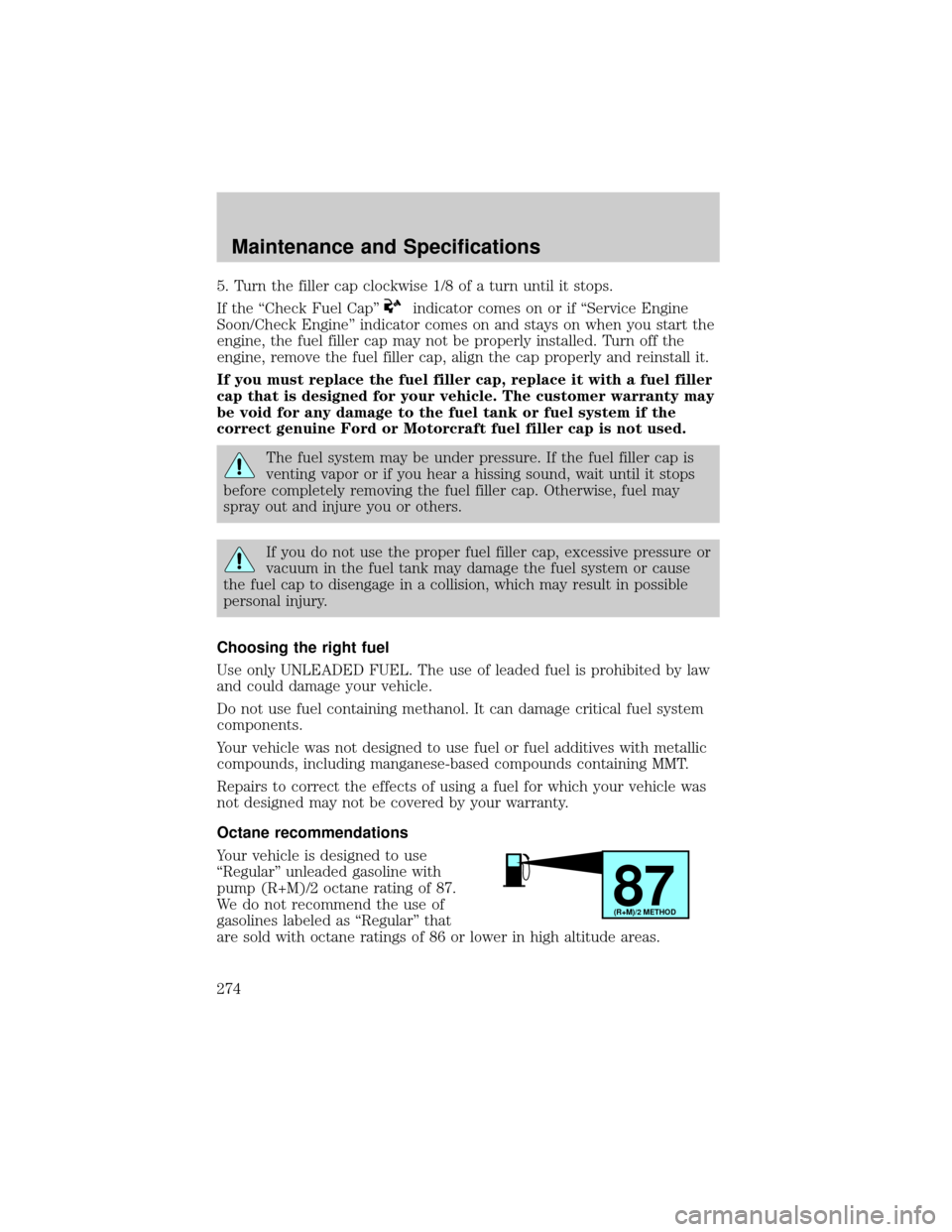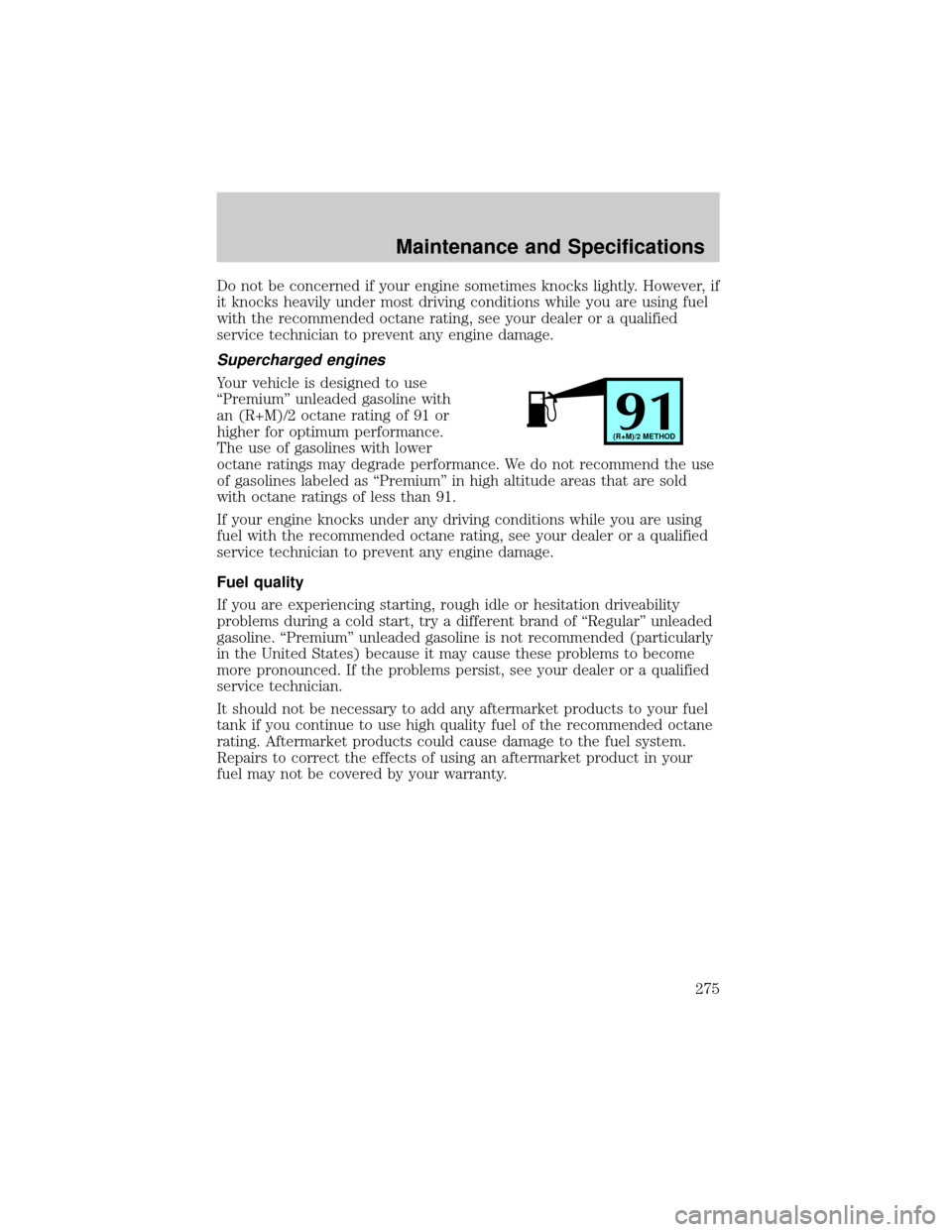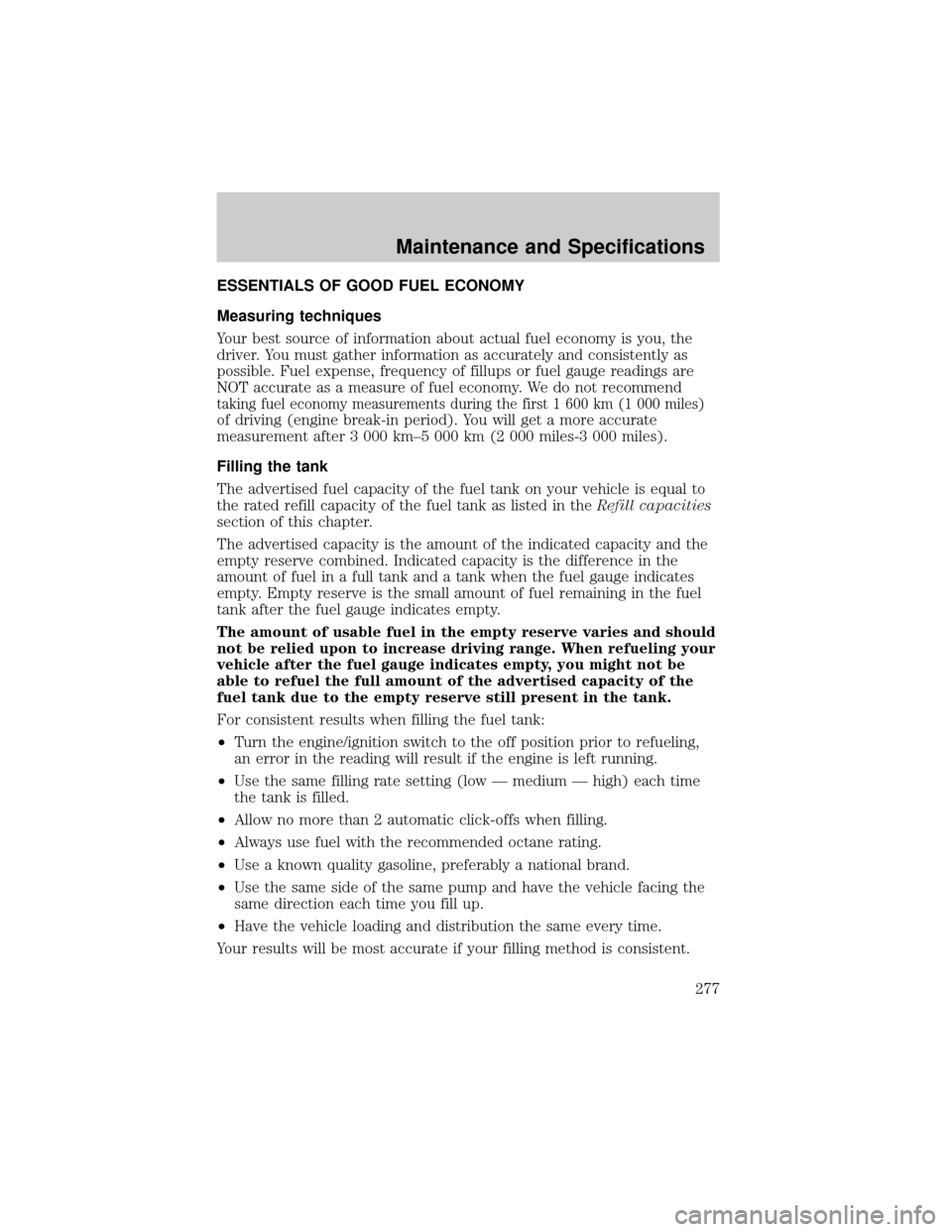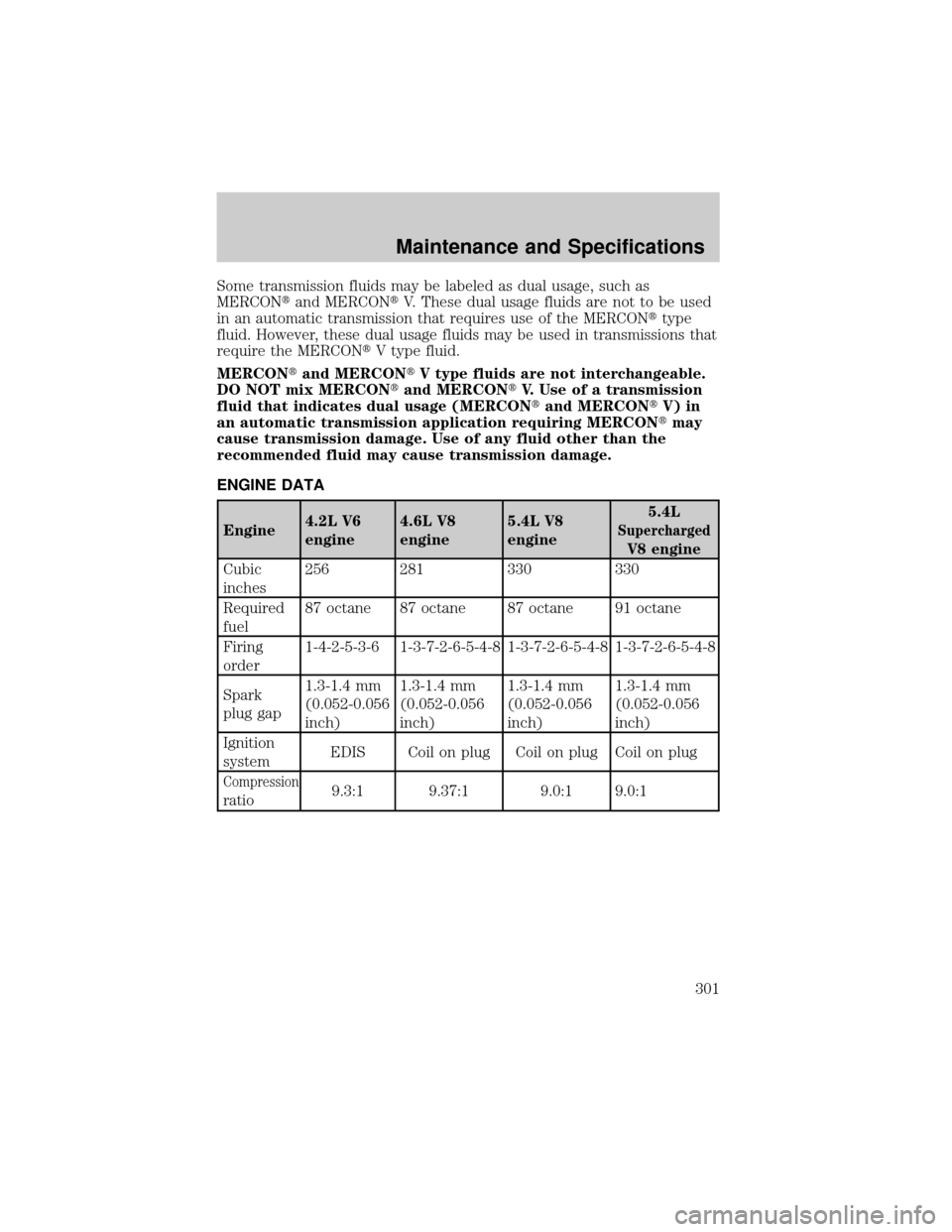octane FORD F150 2002 10.G Owners Manual
[x] Cancel search | Manufacturer: FORD, Model Year: 2002, Model line: F150, Model: FORD F150 2002 10.GPages: 320, PDF Size: 2.95 MB
Page 11 of 320

Warning lights and gauges can alert you to a vehicle condition that may
become serious enough to cause expensive repairs. A warning light may
illuminate when a problem exists with one of your vehicle's functions.
Many lights will illuminate when you start your vehicle to make sure the
bulb works.If any light remains on after starting the vehicle, have
the respective system inspected immediately.
Service engine soon
Illuminates briefly to ensure the
system is functional. If it comes on
after the engine is started, one of
the engine's emission control
systems may be malfunctioning. The
light may illuminate without a
driveability concern being noted. The vehicle will usually be drivable and
will not require towing.
Light turns on solid:
Temporary malfunctions may cause the light to illuminate. Examples are:
1. The vehicle has run out of fuel.
2. Poor fuel quality or water in the fuel.
3. The fuel cap may not have been properly installed and securely
tightened.
These temporary malfunctions can be corrected by filling the fuel tank
with high quality fuel of the recommended octane and/or properly
installing and securely tightening the fuel cap. After three driving cycles
without these or any other temporary malfunctions present, the light
should turn off. (A driving cycle consists of a cold engine startup
followed by mixed city/highway driving.) No additional vehicle service is
required.
If the light remains on, have your vehicle serviced at the first available
opportunity.
Light is blinking:
Engine misfire is occurring which could damage your catalytic converter.
You should drive in a moderate fashion (avoid heavy acceleration and
deceleration) and have your vehicle serviced at the first available
opportunity.
SERVICE
ENGINE
SOON
Instrument Cluster
11
Page 274 of 320

5. Turn the filler cap clockwise 1/8 of a turn until it stops.
If the ªCheck Fuel Capº
indicator comes on or if ªService Engine
Soon/Check Engineº indicator comes on and stays on when you start the
engine, the fuel filler cap may not be properly installed. Turn off the
engine, remove the fuel filler cap, align the cap properly and reinstall it.
If you must replace the fuel filler cap, replace it with a fuel filler
cap that is designed for your vehicle. The customer warranty may
be void for any damage to the fuel tank or fuel system if the
correct genuine Ford or Motorcraft fuel filler cap is not used.
The fuel system may be under pressure. If the fuel filler cap is
venting vapor or if you hear a hissing sound, wait until it stops
before completely removing the fuel filler cap. Otherwise, fuel may
spray out and injure you or others.
If you do not use the proper fuel filler cap, excessive pressure or
vacuum in the fuel tank may damage the fuel system or cause
the fuel cap to disengage in a collision, which may result in possible
personal injury.
Choosing the right fuel
Use only UNLEADED FUEL. The use of leaded fuel is prohibited by law
and could damage your vehicle.
Do not use fuel containing methanol. It can damage critical fuel system
components.
Your vehicle was not designed to use fuel or fuel additives with metallic
compounds, including manganese-based compounds containing MMT.
Repairs to correct the effects of using a fuel for which your vehicle was
not designed may not be covered by your warranty.
Octane recommendations
Your vehicle is designed to use
ªRegularº unleaded gasoline with
pump (R+M)/2 octane rating of 87.
We do not recommend the use of
gasolines labeled as ªRegularº that
are sold with octane ratings of 86 or lower in high altitude areas.
87(R+M)/2 METHOD
Maintenance and Specifications
274
Page 275 of 320

Do not be concerned if your engine sometimes knocks lightly. However, if
it knocks heavily under most driving conditions while you are using fuel
with the recommended octane rating, see your dealer or a qualified
service technician to prevent any engine damage.
Supercharged engines
Your vehicle is designed to use
ªPremiumº unleaded gasoline with
an (R+M)/2 octane rating of 91 or
higher for optimum performance.
The use of gasolines with lower
octane ratings may degrade performance. We do not recommend the use
of gasolines labeled as ªPremiumº in high altitude areas that are sold
with octane ratings of less than 91.
If your engine knocks under any driving conditions while you are using
fuel with the recommended octane rating, see your dealer or a qualified
service technician to prevent any engine damage.
Fuel quality
If you are experiencing starting, rough idle or hesitation driveability
problems during a cold start, try a different brand of ªRegularº unleaded
gasoline. ªPremiumº unleaded gasoline is not recommended (particularly
in the United States) because it may cause these problems to become
more pronounced. If the problems persist, see your dealer or a qualified
service technician.
It should not be necessary to add any aftermarket products to your fuel
tank if you continue to use high quality fuel of the recommended octane
rating. Aftermarket products could cause damage to the fuel system.
Repairs to correct the effects of using an aftermarket product in your
fuel may not be covered by your warranty.
91(R+M)/2 METHOD
Maintenance and Specifications
275
Page 277 of 320

ESSENTIALS OF GOOD FUEL ECONOMY
Measuring techniques
Your best source of information about actual fuel economy is you, the
driver. You must gather information as accurately and consistently as
possible. Fuel expense, frequency of fillups or fuel gauge readings are
NOT accurate as a measure of fuel economy. We do not recommend
taking fuel economy measurements during the first 1 600 km (1 000 miles)
of driving (engine break-in period). You will get a more accurate
measurement after 3 000 km±5 000 km (2 000 miles-3 000 miles).
Filling the tank
The advertised fuel capacity of the fuel tank on your vehicle is equal to
the rated refill capacity of the fuel tank as listed in theRefill capacities
section of this chapter.
The advertised capacity is the amount of the indicated capacity and the
empty reserve combined. Indicated capacity is the difference in the
amount of fuel in a full tank and a tank when the fuel gauge indicates
empty. Empty reserve is the small amount of fuel remaining in the fuel
tank after the fuel gauge indicates empty.
The amount of usable fuel in the empty reserve varies and should
not be relied upon to increase driving range. When refueling your
vehicle after the fuel gauge indicates empty, you might not be
able to refuel the full amount of the advertised capacity of the
fuel tank due to the empty reserve still present in the tank.
For consistent results when filling the fuel tank:
²Turn the engine/ignition switch to the off position prior to refueling,
an error in the reading will result if the engine is left running.
²Use the same filling rate setting (low Ð medium Ð high) each time
the tank is filled.
²Allow no more than 2 automatic click-offs when filling.
²Always use fuel with the recommended octane rating.
²Use a known quality gasoline, preferably a national brand.
²Use the same side of the same pump and have the vehicle facing the
same direction each time you fill up.
²Have the vehicle loading and distribution the same every time.
Your results will be most accurate if your filling method is consistent.
Maintenance and Specifications
277
Page 301 of 320

Some transmission fluids may be labeled as dual usage, such as
MERCONtand MERCONtV. These dual usage fluids are not to be used
in an automatic transmission that requires use of the MERCONttype
fluid. However, these dual usage fluids may be used in transmissions that
require the MERCONtV type fluid.
MERCONtand MERCONtV type fluids are not interchangeable.
DO NOT mix MERCONtand MERCONtV. Use of a transmission
fluid that indicates dual usage (MERCONtand MERCONtV) in
an automatic transmission application requiring MERCONtmay
cause transmission damage. Use of any fluid other than the
recommended fluid may cause transmission damage.
ENGINE DATA
Engine4.2L V6
engine4.6L V8
engine5.4L V8
engine5.4LSupercharged
V8 engine
Cubic
inches256 281 330 330
Required
fuel87 octane 87 octane 87 octane 91 octane
Firing
order1-4-2-5-3-6 1-3-7-2-6-5-4-8 1-3-7-2-6-5-4-8 1-3-7-2-6-5-4-8
Spark
plug gap1.3-1.4 mm
(0.052-0.056
inch)1.3-1.4 mm
(0.052-0.056
inch)1.3-1.4 mm
(0.052-0.056
inch)1.3-1.4 mm
(0.052-0.056
inch)
Ignition
systemEDIS Coil on plug Coil on plug Coil on plug
Compression
ratio9.3:1 9.37:1 9.0:1 9.0:1
Maintenance and Specifications
301
Page 315 of 320

E
Emergencies, roadside
jump-starting ..........................226
Emission control system ..........280
Engine ................................301±302
check engine/service
engine soon light ......................11
cleaning ...................................244
coolant .....................................265
fail-safe coolant ......................270
idle speed control ...................263
lubrication
specifications ..................299, 301
refill capacities ........................295
service points ..................255±257
starting after a collision .........211
Engine block heater .................169
Engine oil ..................................258
checking and adding ..............258
dipstick ....................................258
filter, specifications ........262, 294
recommendations ...................262
refill capacities ........................295
specifications ..................299, 301
Exhaust fumes ..........................169
F
Fail safe cooling ........................270
Floor mats ...................................97
Fluid capacities .........................295
Foglamps .....................................65
Four-Wheel Drive
vehicles ................................15, 184
description ..............................187
driving off road .......................188
electronic shift ........................187indicator light ...................15, 185
lever operated shift ................185
preparing to drive your
vehicle .....................................174
Fuel ............................................271
calculating fuel economy .......277
cap .....................................12, 273
capacity ...................................295
choosing the right fuel ...........274
comparisons with EPA
fuel economy estimates .........280
detergent in fuel .....................276
filling your vehicle
with fuel ..................271, 273, 277
filter, specifications ........276, 294
fuel pump shut-off switch .....211
gauge .........................................18
improving fuel economy ........277
low fuel warning light ..............13
octane rating ...274±275, 301±302
quality ......................................275
running out of fuel .................276
safety information relating
to automotive fuels ................271
Fuses ..................................213±214
G
Garage door opener ..............79, 93
Gas cap (see Fuel cap) ......12, 273
Gas mileage
(see Fuel economy) .................277
Gauges .........................................16
battery voltage gauge ...............18
engine coolant temperature
gauge .........................................17
engine oil pressure gauge ........17
fuel gauge ..................................18
odometer ...................................19
speedometer .............................18
Index
315
Page 317 of 320

daytime running light ...............66
fog lamps ...................................65
headlamps .................................65
headlamps, flash to pass ..........66
instrument panel, dimming .....67
interior lamps .....................68±69
replacing bulbs .............69, 71±75
Lane change indicator
(see Turn signal) ........................67
Lights, warning and indicator ....10
air bag ........................................13
anti-lock brakes (ABS) ....12, 171
anti-theft ...................................15
brake ..........................................12
charging system ........................13
check coolant ............................13
cruise indicator .........................14
door ajar ....................................14
engine oil pressure ...................13
fuel cap light .............................12
high beam .................................14
low fuel ......................................13
low washer fluid .......................14
safety belt .................................13
service engine soon ..................11
speed control ............................92
turn signal indicator .................14
Load limits .................................197
GAWR ......................................197
GVWR ......................................197
trailer towing ..........................197
Loading instructions .................199
Locks
autolock ...................................113
childproof ................................107
Lubricant
specifications .....................299, 301
Lumbar support, seats .............123M
Manual transmission .................178
fluid capacities ........................295
lubricant specifications ..........301
reverse .....................................183
Mirrors .........................................78
automatic dimming rearview
mirror ........................................86
fold away ...................................88
side view mirrors (power) .......87
Moon roof ....................................92
Motorcraft parts ................276, 294
O
Octane rating ....................274±275
Odometer .....................................19
Oil (see Engine oil) ..................258
Overdrive .....................................84
P
Panic alarm feature, remote
entry system ..............................110
Parking brake ............................172
Parts (see Motorcraft parts) ....294
Pedals (see Power adjustable
foot pedals) .................................88
Power distribution box
(see Fuses) ...............................217
Power door locks ..............106, 113
Power steering ..........................173
fluid, checking and adding ....282
fluid, refill capacity ................295
fluid, specifications .........299, 301
Index
317